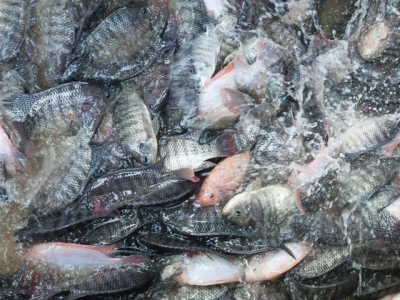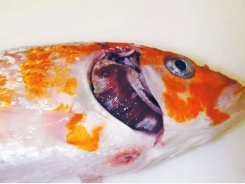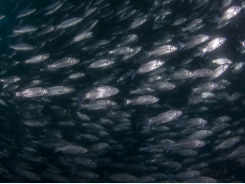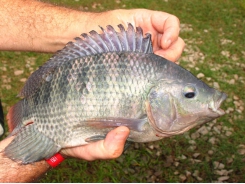Organic selenium additive boosts mineral uptake, may reduce malnutrition

Feeding farmed fish organic instead of inorganic selenium supports fish production and increases concentration of the mineral in fish tissue providing an enriched product, researchers say.
A team of researchers from Virginia Polytechnic Institute and State University, Virginia-Maryland College of Veterinary Medicine, University of North Dakota, and Texas A&M University explored the use of selenium supplementation in the diets of farmed Nile tilapia to provide an enhanced product. The researchers published their work in the journal PLos ONE.
The researchers conducted a feeding trial to “evaluate the effect of Se [Selenium] species as functional ingredients in the diet of Nile tilapia, Oreochromis niloticus,” they said.
“The effects of dietary organic and inorganic Se on growth performance, biometrics, plasma and hepatic GPX activity and tissue assimilation of Se was compared to identify species of Se that lead to higher tissue and plasma concentrations,” the researchers said. “The effect on fish production was evaluated by measuring food conversion ratio (FCR), growth rate, survival, and intestinal microvilli length.”
The researchers found that fish receiving diets with the same level of organic or inorganic selenium displayed similar biometrics and growth performance.
However, fillets from fish receiving the organic selenium diet had higher selenium concentrations than fish on the inorganic diet or in samples acquired from the marketplace, they said. Fish on the organic supplement had increased plasma and kidney selenium as well, compared to tilapia receiving the inorganic selenium diet.
Fish on both diets had similar glutathione peroxidase activity (GPX) in the liver and plasma, they said.
“This study demonstrated that organic Se is a more bioavailable form of Se in Nile tilapia,” the researchers reported. “To produce Se enriched tilapia fillets, organic species of Se should be used by the aquaculture industry as an alternative to inorganic species.”
Aquaculture to address malnutrition
Malnutrition remains a challenge in several parts of the world, the researchers said. Farmed fish provides a high protein food along with other bioavailable micronutrients.
“However, the important role of fish as dietary sources of micronutrients is poorly recognized and under-evaluated."
Increasing global demand for fish is being met through aquaculture, and the industry already produces more than half of the fish consumed, the team noted.
“As the aquaculture industry is growing it is embracing a nutrition-sensitive approach and is moving beyond maximizing productivity to improving nutrition and health of the animal,” the researchers said. “Production of healthier fish with better nutritional quality can in return improve the health of human consumers.”
Why supplement tilapia with selenium?
Minerals play a role in several important biological processes in both humans and animals, the researchers said. Selenium (Se) is a functional component in selenocysteine – and amino acid involved with a unique type of protein (selenoproteins) expressed by all vertebrates.
“One of the best-studied selenoproteins is glutathione peroxidase – this enzyme protects the cell membranes against oxidative damage by catalyzing the reactions that are essential for the conversion of hydrogen peroxide and fatty acid hydroperoxides to water and fatty acid,” they said. “Glutathione peroxidase is measured to evaluate the bioactive status of Se in humans and animal tissues.”
Selenium is involved with maintain fish health and a deficiency in fish has been linked to compromised immunity and increased mortality, they said. Previous research with yellowtail suggests that farmed fish may need a higher level of dietary selenium.
“Due to the beneficial effects of Se for human and animal health this element has been proposed as a valuable resource for including in functional feeds for aquaculture which can promote health and growth of fish as well as improving the quality of their respective fillets for human consumption,” they said. “When supplementing feed with Se, an important consideration is which form of Se to use – supplementation of feed with organic Se can potentially produce fish with higher concentrations of Se for humans to consume.”
Feeding trial details
Prior to the feeding study, 12 tilapia samples were purchased in different regions of the US to establish Se concentrations in commercial fillets, the researchers said.
“The information on Se concentration of tilapia fillets obtained in [the] market study was used to evaluate the success of supplementation of aquafeed with organic and inorganic Se for fortifying Nile tilapia fillets with Se,” they added.
Data on the samples, including how the fish was raised, country of origin, price, certification and fish condition were recorded, they said. The samples were analyzed and checked for element levels including arsenic, calcium, cadmium, copper, iron, molybdenum, magnesium, manganese, sodium, phosphorus, potassium, selenium, and zinc and relative Se availability was calculated.
During the feeding trial, 168 tilapia received one of two trial diets for a seven-week period, the researchers said. The pelleted feeds included either 1mg kg-1 Se in the form of inorganic sodium selenite and organic seleno-L-methionine.
Fish were weighed weekly and Se content in tank water was checked at the start, middle and end of the feeding period to watch for ay Se accumulation, they said. Survival rate, feed conversion rate and weight gain were recorded and the hepatosomatic index (HSI) and viscerosomatic index (VSI) were established.
Sample fish receiving each diet were harvested at the end of the feeding trial and their weight and length noted, they said. Blood samples were taken, and fish fillets, liver, kidney and intestines were collected for analysis.
Results
Regarding the market samples, 11 of the 12 were farm-raised fish predominantly from China, the researchers said. Fish had a positive relative selenium availability.
Following the feeding trial, no mortality was noted for fish on either diet, they said. However, fish on the organic selenium diet had slightly improved growth performance and better feed efficiency than those on the inorganic diet, but HSI and VSI were similar for all tilapia.
“Selenium concentration was significantly higher in plasma, kidney and fillet of fish fed organic Se. However, the concentration of Se was higher in the liver of fish fed inorganic Se,” the researchers said. “Overall, Se accumulation was higher in the liver and kidney compared to fillets or plasma compared with the fish fed inorganic Se.”
“Feeding the organic form of Se led to a significant increase in Se concentrations observed in kidney, plasma and fillets of the fish,” they said. “This appears to be due to differences in the absorption, bioaccumulation and bioavailability of different species of Se (organic and inorganic).”
Total GPX activity in the liver and plasma was similar for fish on both diets as was microvilli size, they said.
“Organic Se fed tilapia had significantly higher concertation of Se in comparison to inorganic fed fish or tilapia samples from commercial markets,” they added.
“In poorer households and developing countries there are limited affordability, availability and even cultural acceptability of food from animal sources that are main sources of micronutrients,” the researchers said. “Therefore, promoting the consumption of value-added fish fillets (i.e. Se enriched) can be used as a whole food approach for solving the problem such as Se deficiency and heavy metal toxicity in developing countries.”
Source: PLoS ONE
Authors: R. Farzad, D.D. Kuhn, S.A. Smith, S.F. O’Keefe, N.V. C. Ralston, A.P. Neilson, D.M. Gatlin
Related news
Tools

Phối trộn thức ăn chăn nuôi

Pha dung dịch thủy canh

Định mức cho tôm ăn

Phối trộn phân bón NPK

Xác định tỷ lệ tôm sống

Chuyển đổi đơn vị phân bón

Xác định công suất sục khí

Chuyển đổi đơn vị tôm

Tính diện tích nhà kính

Tính thể tích ao




 Researchers examine antimicrobial resistance potential in aquaculture
Researchers examine antimicrobial resistance potential in aquaculture  Replacing dietary fish oil with palm oil in…
Replacing dietary fish oil with palm oil in…